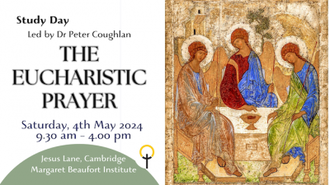Eucharistic Prayers: their origins, meaning and development

It was in the course of a conversation with Dr Anna Abram, Principal of the Margaret Beaufort Institute, that somehow we found ourselves talking about eucharistic prayers. As a result, Anna unexpectedly invited me to lead a Study Day on the topic on 4th May.
As I began to put thoughts together for the Day, my mind was taken back to the1960s when new eucharistic prayers were introduced alongside the Canon of the Mass in the Roman rite. Reflecting on the 1960s reminded me just how turbulent - as well as stimulating and challenging - the 1960s were in church and world. From 1962, when the opening of the Second Vatican Council coincided with the Cuban missile crisis - through and beyond the 1968 explosion of tensions in Europe, the Americas, Asia, and elsewhere - the social upheavals, political developments, and cultural changes of the 60s have been far-reaching.
Decisions regarding how far the vernacular languages should be allowed to replace the Latin texts that had been used over many, many centuries in the Roman rite around the world might seem different in kind to the developments referred to above. Experience has shown, however, that to touch the rites and language of the liturgy is, where many are concerned, to touch areas where their faith has been incarnated, lived, and cherished. Change in this area can affect people deeply.
The Second Vatican Council's Constitution on the Liturgy, approved in December 1963, had achieved a rather fragile balance between the desire 'to preserve the Latin language in the Latin rites', and the recognition that use of the mother tongue may 'frequently be of great advantage to the people' in the liturgy. In 1964 there was considerable tension between the Vatican's already existing Congregation of Rites and the newly established Consilium charged with implementing the Council's liturgical reform. They clashed on the question of how far the vernacular could or should be introduced into the various areas of the liturgy. The Consilium rapidly found itself faced with requests to extend the use of the vernacular, while the Congregation wanted to conserve the use of Latin alone in various parts of liturgical rites.
What happened is that once parts of the liturgy had actually been experienced in the vernacular, an increasing number of Bishops' Conferences wanted its use to be permitted across the board. It was this, following a decision of Pope Paul VI to accept the request of the Bishops' Conferences, that eventually opened up the possibility of making the Roman Canon available in the vernacular. That in turn resulted in a decision, in 1968, to introduce new eucharistic prayers alongside the Roman Canon for the first time in well over a thousand years. The Study Day on 4th May will focus on the theology and spirituality of the eucharistic prayer; it will also offer participants the opportunity to reflect together on the eucharistic prayers at present in use in the Roman rite. The Day will look at the reason those eucharistic prayers came into being when they did, as well as why and how they took their present shape.
Dr Peter Coughlan
Honorary Fellow at Margaret Beaufort Institute
You can join the Study Day on 'The Eucharistic Prayer' led by Dr Peter Coughlan by following this link: Study Day on the Eucharistic Prayer Tickets, Sat 4 May 2024 at 09:30 | Eventbrite
Margaret Beaufort Institute: www.mbit.cam.ac.uk


















